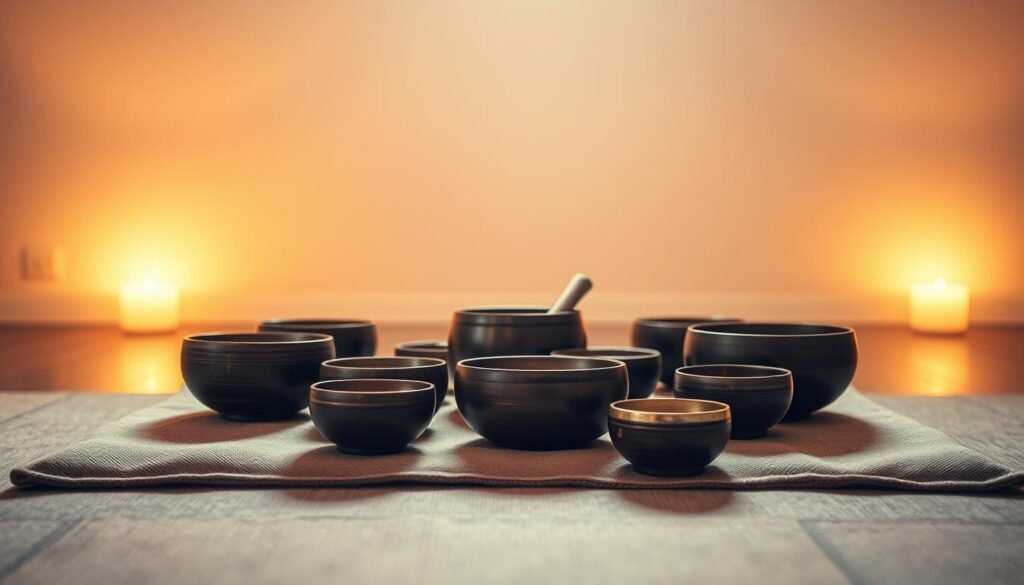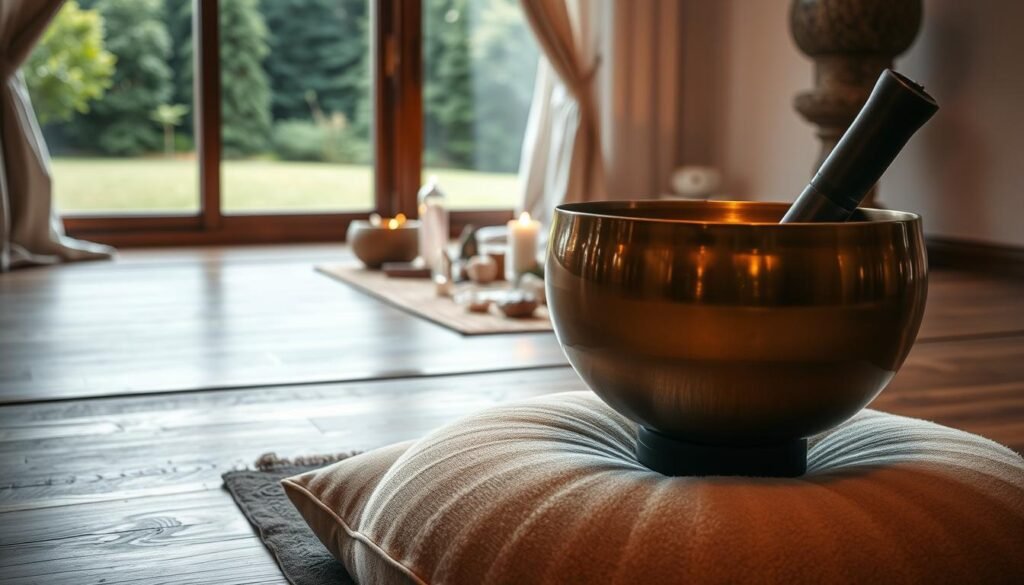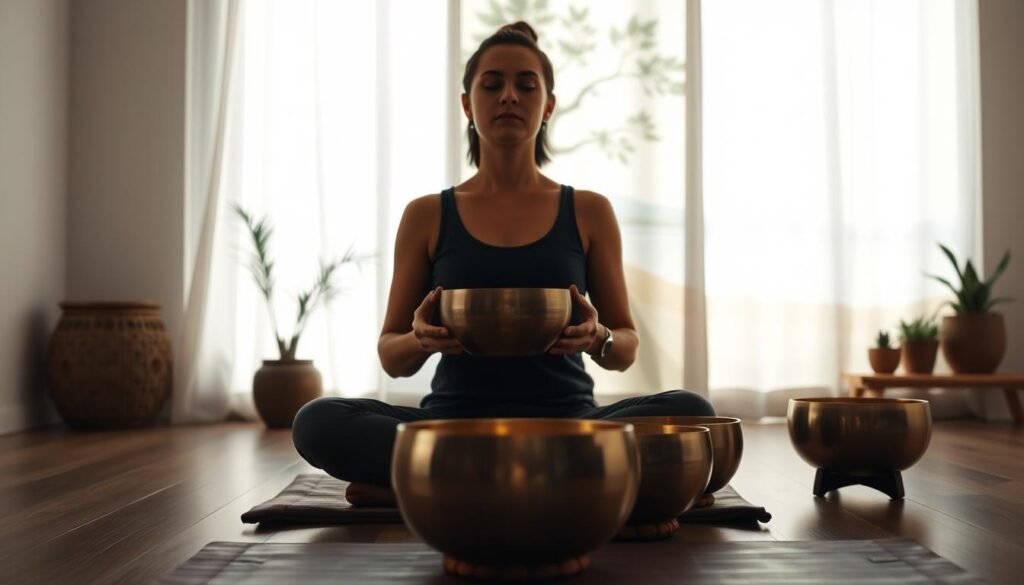
Are you looking for a natural way to ease anxiety and stress? Sound healing with singing bowls is becoming popular for its calming effects. The gentle sounds these bowls make can help quiet your mind and relax your body.
This article will dive into the healing methods of sound healing. We’ll focus on how singing bowl techniques can help calm your anxiety and stress. By learning about these benefits and techniques, you can add this practice to your self-care routine.
Key Takeaways
- Discover the science behind sound healing and its impact on anxiety.
- Learn various singing bowl techniques to promote relaxation.
- Understand how to incorporate sound healing into your daily routine.
- Explore the benefits of using singing bowls for stress relief.
- Find tips on selecting the right singing bowl for your needs.
Understanding the Basics of Singing Bowls
To fully appreciate the role of singing bowls in alleviating anxiety and stress, it’s essential to understand their fundamental principles. Singing bowls, an ancient instrument used in various cultures, have been a cornerstone in sound therapy for stress relief.
What Are Singing Bowls?
Singing bowls are instruments that produce sound when played, typically by striking or singing around their rim. This action creates a rich, deep tone believed to have healing properties. The bowls are often made from metal alloys and are used in meditation and sound healing practices, including the use of Tibetan singing bowls for anxiety.
History and Origin
The history of singing bowls is deeply rooted in the Himalayan region, notably in Tibet and Nepal. These bowls have been used for centuries in religious and spiritual practices. Their origins are tied to the ancient cultures of the region, where they were believed to possess spiritual significance.
The use of singing bowls spread across various cultures, adapting to different spiritual practices. Today, they are recognized worldwide for their therapeutic benefits, including sound therapy for stress relief.
Types of Singing Bowls
There are several types of singing bowls, each with its unique characteristics and sound. The most recognized are:
- Tibetan Singing Bowls: Known for their rich, deep tones, these bowls are often used in meditation and healing practices.
- Nepalese Singing Bowls: Similar to Tibetan bowls but may have different metal compositions, affecting their sound.
- Crystal Singing Bowls: Made from quartz crystal, these bowls produce a clear, ringing sound.
Understanding the different types of singing bowls can help individuals choose the most suitable for their needs, whether it’s for meditation, sound therapy, or simply for relaxation.
The Science Behind Sound Healing
The science shows that singing bowls’ vibrations can change how we feel inside and out. This is key to understanding how mindfulness practices with singing bowls help us relax.
Sound healing works by using certain sounds to improve our health. When we hear a singing bowl, it’s not just the sound. It’s the vibrations that can change our body.
How Sound Affects the Body
Sound waves from singing bowls can make us feel calm by lowering stress and anxiety. They slow down our brain and heart, helping our body relax.
- The sound waves can lower cortisol levels, reducing stress.
- They can also make us feel better by releasing endorphins, or “feel-good” hormones.
- Also, the vibrations can lessen inflammation and boost our immune system.

The Role of Frequency in Healing
Different sounds have different effects on us. Lower sounds help us relax and ease pain. Higher sounds can help us focus and think clearer.
Relaxation techniques with sound bowls use specific sounds for each need. This could be for less anxiety or better sleep.
Benefits of Sound Therapy
Singing bowls offer many benefits for our health. They can:
- Lessen stress and anxiety
- Improve our mood and emotional health
- Help us relax and sleep better
- Boost our focus and mental sharpness
By adding mindfulness practices with singing bowls to our day, we can use sound healing to better our lives.
Creating a Calm Environment for Practice
Creating a peaceful space is key for stress relief with singing bowls. A well-designed area boosts the power of holistic stress management techniques through sound therapy.
Choosing the Right Space
Finding the right spot for singing bowl practice is crucial. Look for a quiet, cozy spot where you can sit and unwind. Make sure it’s free from clutter and noise.

Importance of Atmosphere
The feel of your practice area greatly affects your singing bowl experience. Dim lights and soft candles can make it serene. Adding calming scents like lavender can also help.
Keeping the room at a comfortable temperature is also important. This helps you relax better. Aim to create a peaceful space that encourages deep relaxation.
Preparing Your Mindset
Before starting, get your mind ready. Clear your thoughts with deep breathing or a short meditation. This helps you focus.
With a calm space and a clear mind, your singing bowl practice will be more effective. It will help you manage stress better and improve your overall well-being.
Techniques for Using Singing Bowls
To get the most out of singing bowl meditation for anxiety, learning different playing techniques is crucial. Singing bowls provide a special sound healing experience. Knowing how to use them well is key to making a calming atmosphere.

Basic Playing Techniques
First, learn the basic playing techniques for singing bowls. Hold the bowl in your hand or on a cushion, depending on its size. Use a mallet to strike the bowl gently or run it around the rim.
Try different pressures and speeds to find the sound that resonates with you.
Different Striking Methods
There are many striking methods to try with singing bowls. You can strike the bowl on the side or on the rim, each making a different tone. Some like a gentle tap to start the sound, while others prefer a firmer strike for deeper resonance.
Try these methods to find what works best for you.
Creating Harmonies
To create harmonies, play multiple bowls together. Start with a few that sound good together in tone and pitch. Try different sequences and combinations to make a harmonious sound.
This sound helps relax and reduce anxiety.
Mastering these techniques will improve your singing bowl meditation. It will help you feel more calm and well.
Combining Singing Bowls with Meditation
Singing bowls can make your meditation better, helping you relax and feel calm. Adding their soothing sounds to your meditation can help you focus better. This leads to a deeper sense of inner peace.

Guided Meditations with Singing Bowls
Guided meditations with singing bowls are great for easing anxiety. These meditations use a soft, guided story and the singing bowls’ calming sounds. Find a quiet, comfy spot to sit or lie down without being distracted.
Start by playing the singing bowl softly. Let its sound fill the space. Then, follow a guided meditation or just focus on your breath. Let the bowl’s sound help you relax deeper.
Mindfulness Practices
Mindfulness is about being fully present and observing your thoughts and feelings without judgment. Adding singing bowls to mindfulness makes it even more powerful. As you listen, focus on the bowl’s vibrations and how they affect you.
Feel the sound’s vibrations inside you. Let go of any tension or stress. This can increase your awareness and calmness.
Breathing Techniques
Breathing techniques are key in meditation and singing bowls can enhance them. Try breathing in sync with the bowl’s sound. Inhale as the sound starts, and exhale as it fades.
This breathing can calm your nervous system, reducing anxiety. Try different breathing patterns to find what works for you.
Incorporating Visualization Techniques
Visualization can make your singing bowl experience even better. It helps you relax and feel calm. By using your mind’s eye, you can get more out of sound healing.

Visualizing Calmness
Start by sitting comfortably and playing your singing bowl. Close your eyes and picture a peaceful place. It could be a quiet beach, a forest, or a mountain.
Tips for Effective Visualization: Make your vision real by using all your senses. For example, if you’re at the beach, listen to the waves, feel the sand, and smell the sea.
Imagery to Enhance Experience
Imagery can make your singing bowl practice even better. As you listen, see the vibrations calming your body. Imagine stress leaving with each sound.
- Visualize a warm, calming light filling your body.
- Imagine roots growing from your feet, grounding you.
- Picture a protective shield around you, repelling negative energy.
Setting Intentions
Setting intentions helps you focus and reach your goals. Before starting, decide what you want to achieve. It could be less stress, better sleep, or deeper meditation.
Example Intentions: “I intend to let go of all stress and anxiety,” or “I aim to cultivate a deeper sense of inner peace.”
Using visualization in your singing bowl practice makes it more effective. It helps you calm anxiety and stress better.
Exploring Different Session Lengths
The length of your singing bowl session can greatly affect how relaxed you feel. The time you spend with singing bowls can change how much stress you release.

Short Sessions for Quick Relief
Short sessions are great for beginners or when you need a quick break. Short sessions, lasting from 5 to 15 minutes, can quickly lower your stress and tension. They’re easy to add to your day, giving you a quick calm moment.
- Quick stress relief
- Easy to fit into a busy schedule
- Ideal for beginners
Longer Sessions for Deep Relaxation
If you want to relax deeply, try longer sessions. Longer practices, from 30 minutes to an hour, can deeply release tension and help you meditate. These are good for those with ongoing stress or anxiety.
- Deeper relaxation and stress relief
- Enhanced meditation experience
- Better suited for those with chronic anxiety
Finding Your Ideal Duration
Finding the right singing bowl session length is personal. Try different lengths to see what works for you. Listen to your body and adjust your practice as needed.
Think about your schedule, comfort, and what you want to achieve. Whether you like short, frequent sessions or longer ones, make it a regular and enjoyable part of your life.
Tips for Beginners
Singing bowls are a unique way to manage stress and anxiety. With a few simple tips, beginners can get the most out of them. It’s important to know the basics and how to use them well.
Getting Started with Your First Bowl
Choosing your first singing bowl is exciting. Look for a bowl that’s 6-8 inches in size. It’s easier to handle and sounds great. Choose a bowl made from high-quality materials like bronze or crystal for better sound.
To play, hold a mallet like a pen and strike the bowl’s rim. Try different ways to strike to find what works for you. Start with soft touches and get firmer to get the right sound.

Common Mistakes to Avoid
Don’t strike the bowl too hard. It can sound harsh. Be gentle and controlled for a smooth sound. Also, don’t skip practice. Regular use makes singing bowls more effective for stress and anxiety.
- Striking too hard or too softly
- Not practicing regularly
- Not experimenting with different techniques
Enhancing Your Practice
To get more from singing bowls, use them in meditation or mindfulness. Deep breathing exercises with singing bowls can help more. Try different places to see what works best for you.
- Practice in a quiet, comfortable space
- Use the singing bowl during meditation or yoga
- Experiment with different bowl sizes and materials
By avoiding common mistakes and practicing regularly, beginners can use singing bowls well. With patience and practice, you’ll see their benefits.
Integrating Singing Bowls into Daily Life
Adding singing bowls to your daily routine can help reduce stress and anxiety. These bowls can make your mindfulness practices with singing bowls more effective. They help you live a more balanced life.

Using Singing Bowls in Morning Routine
Starting your day with singing bowls can make mornings better. It clears your mind and gets you ready for the day. Just find a quiet spot, strike the bowl softly, and let the sound calm you.
Try deep breathing or a short meditation with the bowls. This can bring calm and clarity that lasts all day.
Evening Wind-Down with Sound
Using singing bowls in the evening can help you relax after a busy day. The soothing sounds tell your body it’s time to sleep. Play the bowls in a dim room for a cozy feel.
Play with different striking techniques to match your mood. A slow, deliberate strike can calm your mind and bring peace.
Group Sessions for Community Support
Joining group singing bowl sessions can connect you with others. It’s a chance to meet people who share your interest in mindfulness and sound healing. Many groups offer these sessions, or you can start one with friends or family.
Group sessions can make sound healing even more powerful. The energy of the group can boost the experience. It’s a great way to bond with others while deepening your mindfulness practice.
Personal Experiences with Singing Bowls
Singing bowls offer comfort to many, providing a unique way to manage anxiety. People who use singing bowls for anxiety relief share their positive experiences. These stories show how effective singing bowls can be.
Testimonials from Users
Many have found Tibetan singing bowls for anxiety to be very helpful. Sarah, for example, used singing bowls to reduce her stress and improve sleep. She noticed a big difference.
John also found benefits from using singing bowl healing methods. He felt more calm and grounded every day. He made singing bowls a part of his daily routine.

Case Studies on Anxiety Relief
Studies have looked into how singing bowls affect anxiety. One study showed that singing bowl users had lower anxiety levels than non-users. This is a clear sign of their effectiveness.
- A study in the Journal of Evidence-Based Complementary & Alternative Medicine found sound healing, including singing bowls, helped with anxiety and depression.
- Another study showed singing bowls helped patients manage their anxiety better in a therapeutic setting.
Sharing Your Journey
We invite you to share your experiences with singing bowls. If you’ve found relief from anxiety or enjoy their calming effects, your story matters. It can help others understand the benefits of this ancient practice.
By sharing, you join a community that values sound therapy. Together, we can discover more ways to use singing bowl healing methods for better mental health.
Resources for Further Learning
To learn more about sound therapy for stress and anxiety, there are many resources. You can find books and courses that teach how to use singing bowls for anxiety relief.
Recommended Books and Courses
Check out “The Sound Healing Book” and online courses on Udemy and Coursera. They offer detailed guides on sound therapy techniques.
Online Communities and Classes
Join online forums like Reddit’s r/SoundHealing and local sound healing classes. This way, you can meet others who share your interest and improve your skills.
Apps and Tools for Practice
Use apps like Insight Timer and Omvana for guided sound healing sessions and meditation. They help enhance your singing bowl practice for stress relief.
